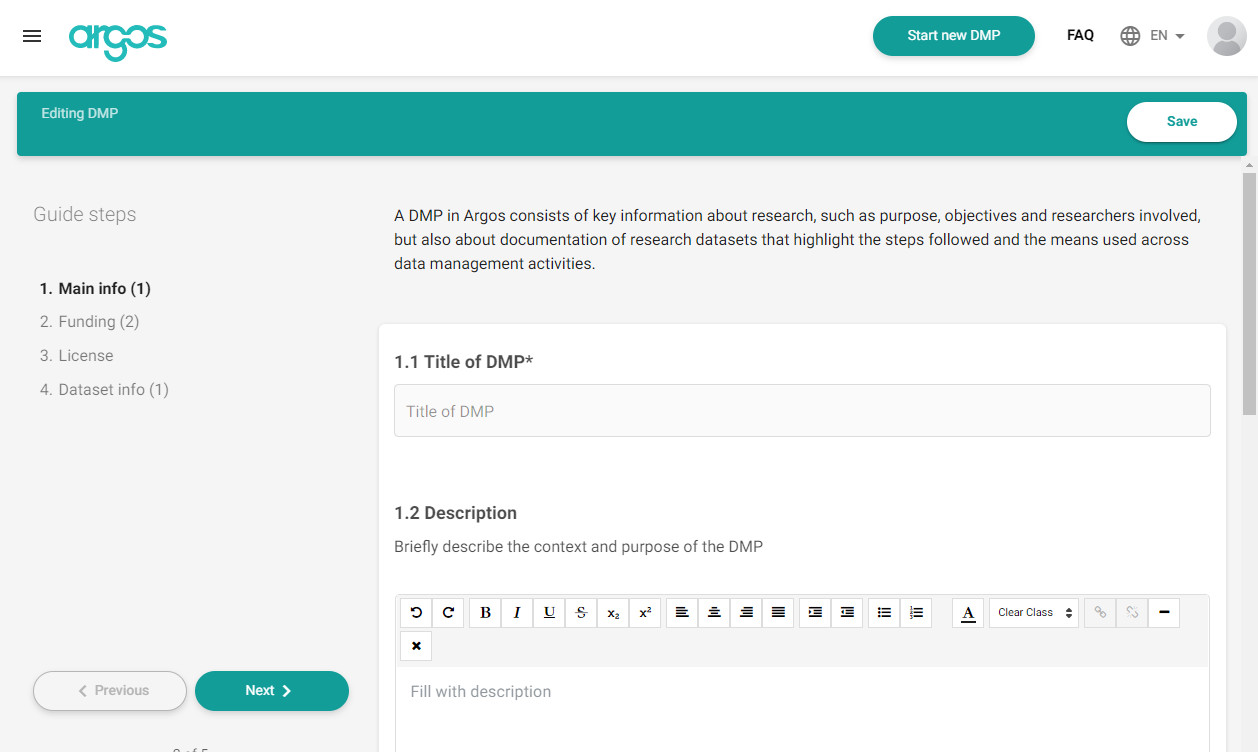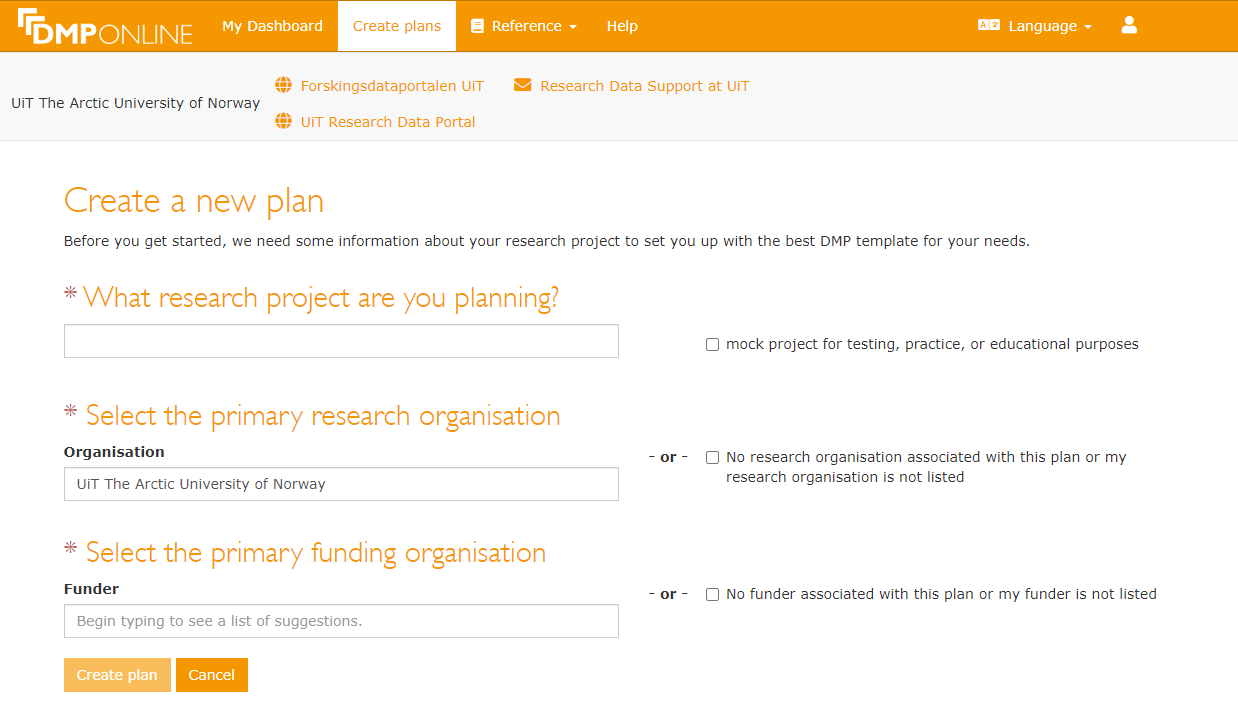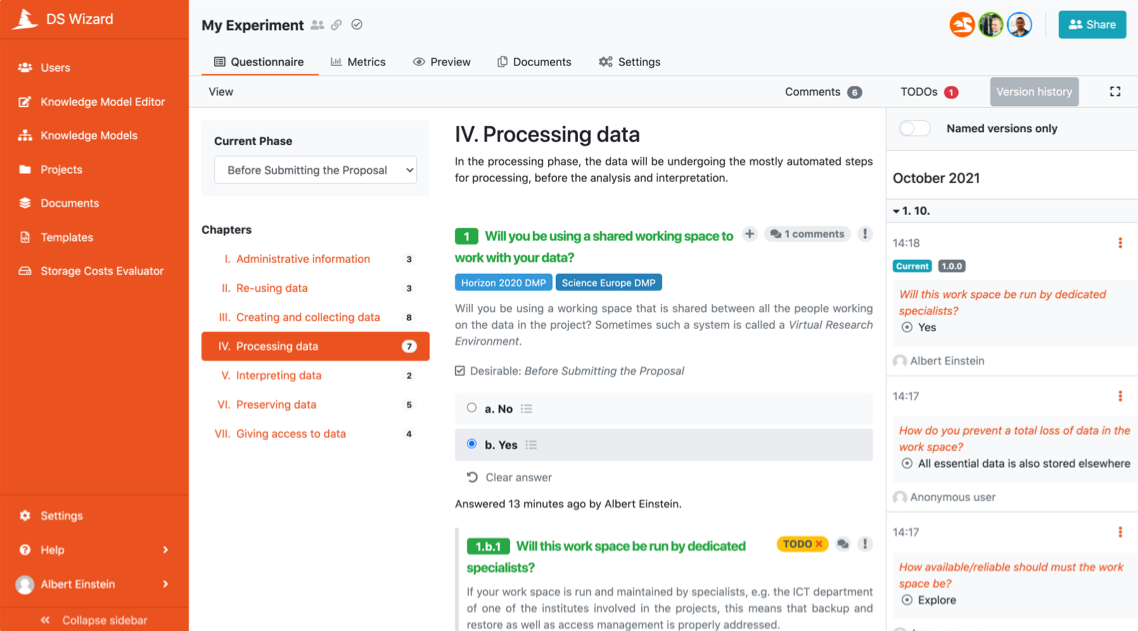9.3 On DMP tools and templates
How do you make sure you include everything that should be included in your Data Management Plan? Looking for good examples of DMPs is one good tip. Looking for and using a good DMP template is another. A template is very useful since it helps you to remember all the elements that should be included in a DMP, and will guide you nicely step by step in how and where they should be entered.
DMP templates can consist of a standalone document or be provided through an electronic DMP tool. The best tool and template for you to use may be one especially suited for your area of research, to your funder or institutional requirements and relevant legislation, or one that has been specifically developed for the type of project you are working on. There are various DMP tools available that include templates you may use to write your DMP. Universities and research institutions may subscribe to these services and make their own tailor-made template(s) and guidelines available. Funders too may enter their requirements for the DMP for projects they fund. The templates can also be designed to suit research within specific subject areas (sometimes called Domain Data Protocols), or even tailored to suit a specific (and big) research project. So, a user may find a template where both their discipline-specific needs, as well as their institution’s and their funder’s requirements are met.
You should start by checking whether there are some requirements on writing a Data Management Plan that apply to you. This may be from your institution or from your funder. Ask your supervisor, your peers, your local research support service, and your funder what applies to you when it comes to requirements and recommendation regarding your DMP. Such requirements may also be tied to a recommended DMP template to use. Does your university have an institutional agreement with a DMP service provider, or do they recommend specific tool? Will the support service offer help and guidance in the use a specific tool? Perhaps your PhD project is part of a bigger project. This bigger project likely has its own DMP. A requirement may then be for you to use a DMP template that complies with the overarching DMP. In that case, you may benefit from reusing some information from the bigger project’s DMP in your own. And vice versa: Information in your DMP may be useful input to the DMP of the umbrella project.
Here is a short list of DMP tools that offer templates commonly used to create Data Management Plans. These are open-source software and free to use for an individual researcher, and they comply withScience Europe’s core requirements for Data Management Plans and their guidelines:Argos

ARGOS (or OpenDMP) is a service developed jointly by OpenAIRE and EUDAT, both organisations that support research infrastructure development. The service is available as a standalone service under the name OpenDMP, and also as a OpenAIRE integrated service under the name of ARGOS. It has been developed to be interoperable with other monitoring and administrative tools and is therefore quite technically advanced, but it does not offer guidance for researchers on how to fill in the DMP. ARGOS/OpenDMP integrates with Zenodo for easy transfer and publishing of the DMP.
DMPOnline

DMPOnline is the DMP service which is most frequently used among European researchers. It builds on the same open-source code-base as the American DMPTool. It was developed and is run by Digital Curation Centre (DCC). University and research institutions subscribing to the service may provide their users with support and tailor-made template(s) and guidelines within the platform. This makes DMPonline user-friendly and well-suited for collaborative projects. In addition to the publicly available platform, there are also several national and institutional instances accessible only to accredited users ( e.g. DMPTuuli in Finland and OpIDOR in France). DMPonline also offers users to publish their DMP in DMPonline. DMPs from others are thus available and may be of good help as examples.
Data Stewardship Wizard

Data Stewardship Wizard (DSW) was developed by the University of Chemistry and Technology, Prague, as part of ELIXIR’s RDM Toolkit. ELIXIR (elixir-europe.org) is an organisation for Life Science resources in Europe, and their cloud service is primarily for ELIXIR-affiliated research. Similar to DMPonline, it is possible for organisations to pay to have their own instance, and tailor the DMP templates to the needs of any research area. The DMP is built as a dynamic structured questionnaire with guiding texts that will provide you with decision support, input and tips on points to consider while writing your DMP. The DSW is technically advanced, with support for ontologies and controlled vocabularies. And there is reporting on FAIR metrics as you complete the form.
Evolving tools
Data Management Plans and their tools are evolving, and developing as machine actionable, meaning that they are supporting the possibility of being integrated with other tools and registries, for the reuse of data and information. The goal is that information should only be entered once, and updates should be entered at one single spot, and then, through integration be reused wherever the information is useful: In applications, in project plans, in research registries and CRIS systems, and in repositories. Machine actionable tools and their many applications are something to look out for.
Lessons learned
- A DMP template will be a useful guide to what you should include in your Data Management Plan.
- Look for templates that your funder or your university points to as suggested or recommended templates.
- Online available DMP tools will have functionality that may be useful as you move forward in your project.
- Online available DMP tools may also be a good place to share your DMP, to the benefit for yourself and others.
Food for thought
Ask your supervisor and also some other professors and fellow PhD candidates if they know of a DMP tool or template they would recommend. What functionality in a DMP tool do you consider to be beneficial for your own needs? Can you think of reasons for not sharing your DMP?